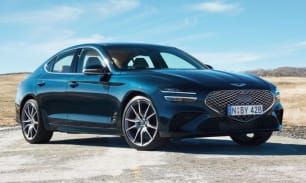The S6 sedan has no right being this good in a straight line and around corners…
Much of its success is owed to the 2.9-litre twin-turbo V6, which is now one of my favourite engines being built today. Simply put, it absolutely hammers.
Punch the accelerator from a standing start and it doesn’t take long for 600Nm to be on tap all the way through, and just a little bit beyond, the mid-range.
Occupants are firmly pressed into their seats as the S6 sedan sprints towards the horizon with vigour. Soon enough, 331kW arrives and hangs around until just prior to the redline.
Needless to say, this acceleration is addictive, and the EPC deserves some of the credit, as it effectively mitigates any dreaded turbo lag and ensures the engine is always seemingly on boost.
But we also need to acknowledge the eight-speed torque-converter automatic, which is a real beauty. Gear changes are nice and smooth, which is great, but what’s even better is their relative quickness – dual-clutch transmissions be damned!
Of course, extra performance can be extracted by switching between the engine and transmissions’ settings but, rest assured, they both stand up, no matter what.
However, we’d suggest spending time in the former’s most aggressive setting, as it unleashes the sports exhaust system, which sounds unreal.
Upshift with intent and you’re met with a booming ‘brap’. Downshifts and the overrun will even gift you a series of pops. In fact, the S6 sedan soundtrack sounds strangely similar to that of the five-cylinder RS3, and we have absolutely no problem with that.
Better yet, the S6 sedan has an appetite for corners, with its neutral handling a standout, partly thanks to its hard-working rear-biased quattro all-wheel-drive system, which works in tandem with all the other electronics to ensure there is plenty of grip at any given time.
This controlled driving pleasure is enhanced by the electric power steering on hand, which has a variable ratio. At low speed, it’s nice and light, but those after more heft can always switch to another one of its settings, which become progressively heavier… arguably too heavy.
Feedback through the wheel is also good, while the steering itself is pretty direct, lending itself to sporty driving, which, of course, is half of the S6 sedan’s mantra.
Coming into corners, braking performance is solid, thanks to the massive 400mm front and 350mm rear discs with red callipers, so the driver is brimming with confidence at every turn, even though there’s an unladen weight (with 75kg driver and luggage) of 1985kg to manage.
But let’s not forget the S6 is an executive sedan, so it has to ride like one. Thankfully, it does. The independent five-link suspension has air springs and adaptive dampers, which serve up comfort in spades, especially at high speed.
Its firm tune does come into frame when travelling on unsealed or uneven roads, with this exacerbated by the large 21-inch alloy wheels, which have a penchant for catching sharp edges.

